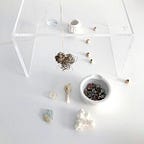Urban Fiber Flotsam | Revisited
It has been eleven years since I worked on a public art and crafting project called, Urban Fiber Flotsam (UFF). So much has transpired since then, but in looking back to early September 2008, the underpinnings for the concept of UFF still remains nested within my practice and studio materials research.
The premise of UFF was to revisit select principles of psychogeography and the dérive act of urban drifting. Marx theorist and Situationist, Guy Debord, explored this method as a means to revisit the way that we experience urban spaces. Rather than being prisoners to a daily route and routine (navigating a complex city but treading the same path every day), he urged people to follow their emotions and to look at urban situations in radical new ways. (This was tied to the notion that most cities are thoroughly unpleasant for many of us as they are designed to be devoid of emotional impact, and in many cases, try to control or falsely direct people through their very design). Citizen navigators instead should be encouraged to (intuitively) explore urban routes without preconceptions, to understand their true location, and in turn their overall existence. Drifting was a means of experiencing surroundings anew — seeking connections that might speak to other freedoms and attractions of the terrain.
By mapping a route in lower Manhattan and gathering ‘flotsam materials’ that became nodes or markers in a system of personal documentation, I also ‘spun’ together these findings as a record of my spontaneous movements and the overall synthesis and cohesiveness of space. Disparate findings and materials became entwined over time, as the very act of walking helped me to distill my ‘ingredients’ down to a more unified state.
In revisiting UFF again, I realized that the genesis of Walking Libraries was rooted in this earlier public art project and the desire to fuse found or cast-off materials with mapping/movement arts in a way that might address organic relationships, atmospheric phenomena, and the connective threads of place.
Notes from Urban Fiber Flotsam (2008 | NYC):
flot·sam
pronunciation:
\ˈflät-səm\
etymology: Anglo-French floteson, from ‘floter’ to float, of Germanic origin; akin to Old English flotian to float, flota ship
date: circa 16071: floating wreckage of a ship or its cargo; broadly : floating debris
2 a: a floating population (as of emigrants or castaways) b: miscellaneous or unimportant material c: debris, remains
[ The vegetation collected was not picked from live plants but found on urban streets, sidewalks, and in crevices or on paved surfaces along my route. ]
Materials included: deflated party balloons, packing tape, Chinese food wrappers, dried grasses, found leaves/buds, garment threads, cotton gima fiber, clothing scraps, mohair, angora, pre-spun wool, and a popsicle stick.
Urban Fiber Flotsam was part of the Conflux Arts festival in lower Manhattan in September 2008. All images © Abigail Doan.
